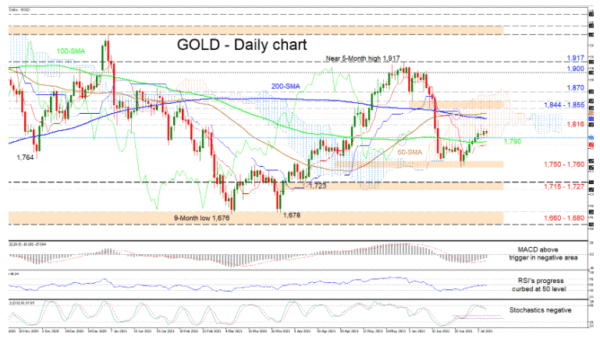Gold’s latest rally that began from the 1,750 level seems to have slowed down just above the 1,800 mark. Directional forces seem to have toned-down, something also being reflected in the overall weakened bearings of the simple moving averages (SMAs), and the horizontal Ichimoku lines.
The short-term oscillators are also transmitting conflicting signals in directional momentum. The MACD, in the bearish region, is improving above its red trigger line, while the RSI appears to be lacking positive drive to push into the bullish zone. The negatively charged stochastic oscillator is signalling growing negative forces.
If buyers manage to thrust above the nearby 1,816 high, early resistance could develop between the 200- and 50-day SMAs of 1,827 and 1,836 respectively. Another leg higher, the barricade of 1,844-1,855 could generate some opposition for the bulls to lift the price to test the 1,870 barrier. However, successfully breaching this too could encourage buyers to revisit the 1,900 border and maybe even shoot for the near 5-month peak of 1,917.
Otherwise, just below the 1800 mark downside limitations may commence from the cloud’s lower surface at 1,797 until the red Tenkan-sen line at 1,786, an area, which also contains the 100-day SMA at 1,790. Effectively steering beneath these obstacles, sellers may lead the price to the support section of 1,750-1,760, recently formed between the troughs of June 18 and 29 respectively. Should the yellow metal remain heavy, the support base of 1,660-1,680 could become the bears’ next target, shaped from the lows from the end of April up to early June, as well as the 9-month low of 1,676 and the following trough of 1,678.
As things currently stand, gold remains somewhat undecided upward of the 1,800 level, as directional forces have become relatively muted. A climb above the SMAs and the cloud could boost upside confidence, while a close beneath the 1,750-1,760 support may reinforce negative pressures.













